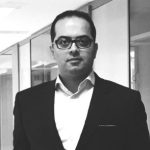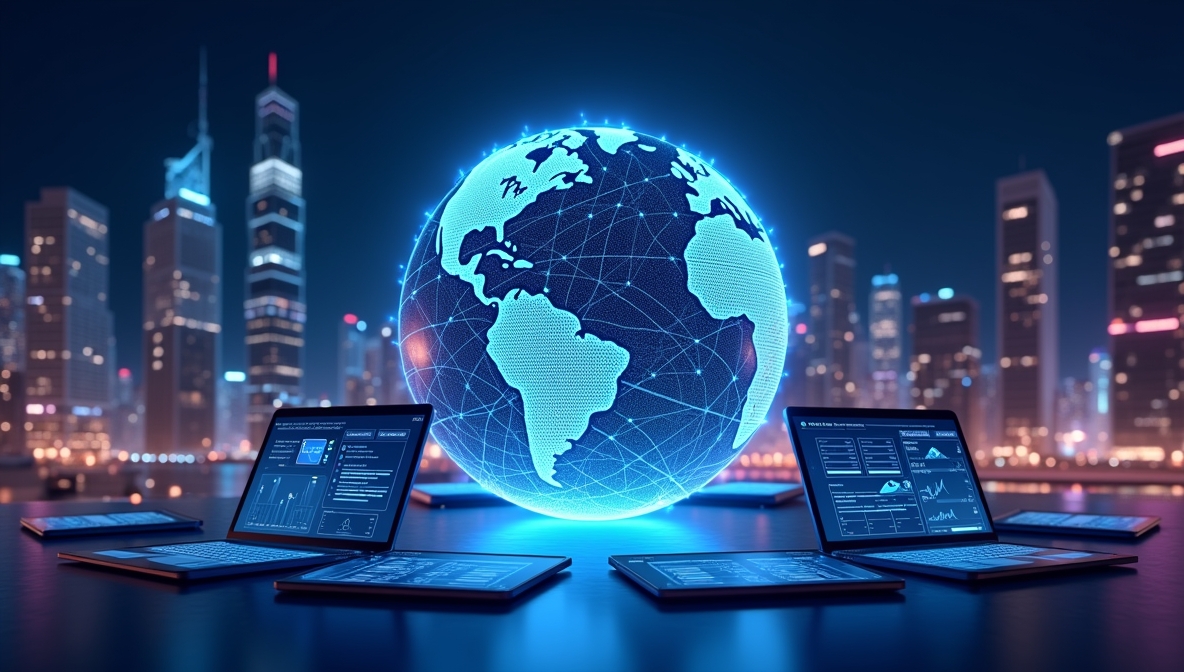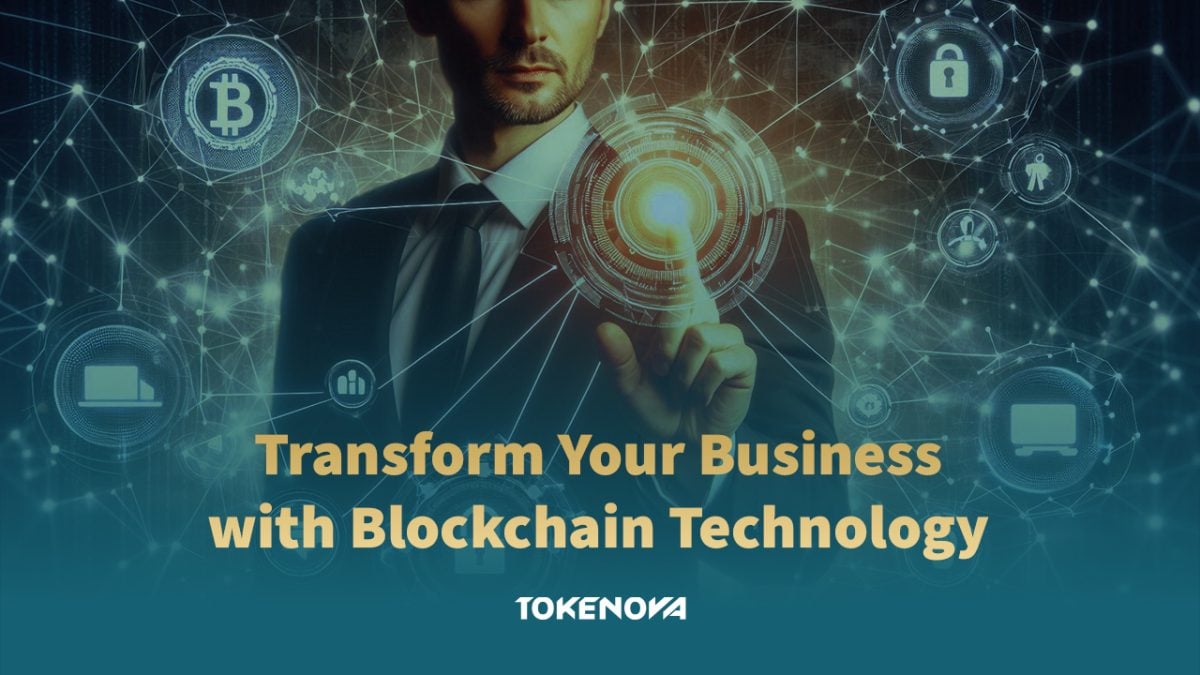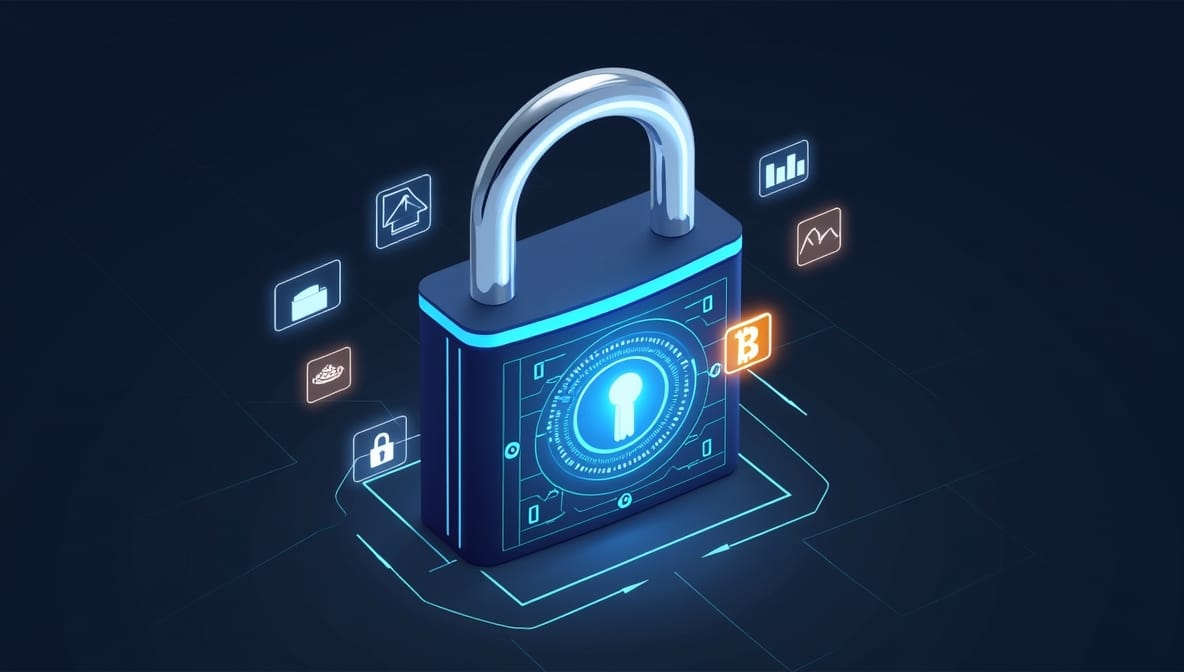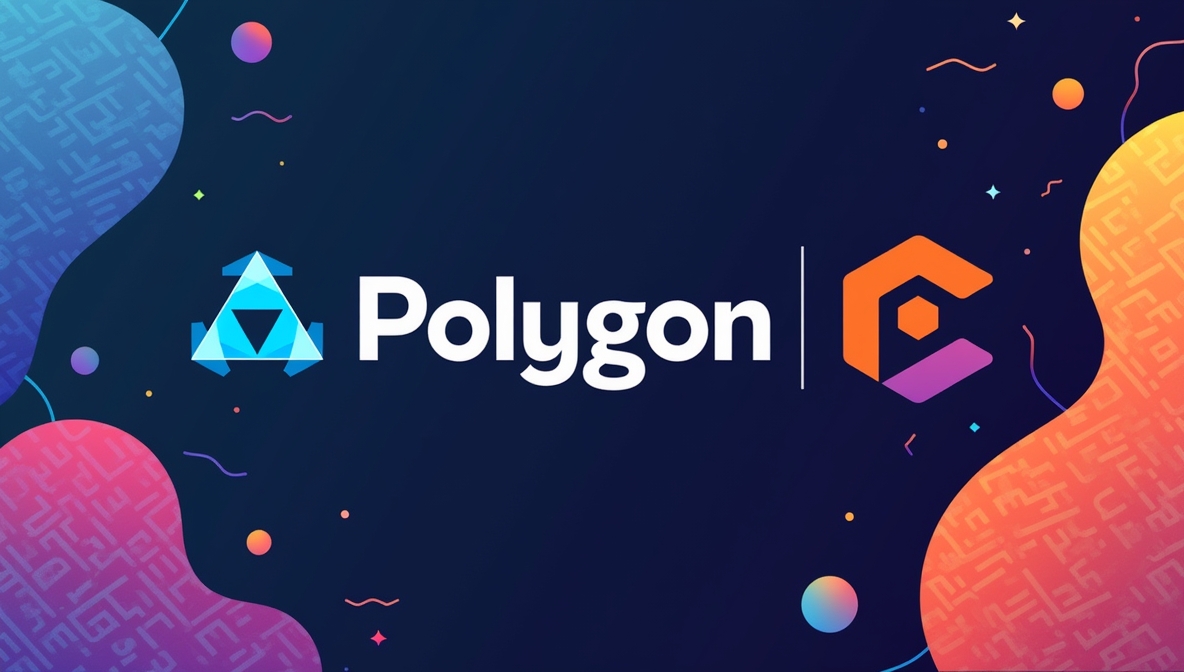Layer-2 solutions in blockchain have emerged as a crucial innovation addressing the scalability limitations of major networks like Bitcoin and Ethereum. As blockchain adoption grows, issues like network congestion, high fees, and slow speeds hinder its real-world usability. Layer-2 solutions in blockchain tackle these problems by processing transactions off-chain or bundling them before final confirmation on Layer 1, enhancing efficiency without compromising security.
Technologies such as Optimistic Rollups, ZK-Rollups, Sidechains, Plasma, and State Channels are driving improvements in transaction speed and cost, enabling broader use cases like DeFi, NFTs, gaming, and micropayments. This guide explores the mechanics, benefits, and future of layer-2 solutions in blockchain, highlighting their role in scaling blockchain for widespread adoption.
Decoding Layer 2: The Scalability Secret Unveiled
To truly grasp the significance of Layer 2 solutions, we must first understand the fundamental problem they address: blockchain scalability. Original Layer 1 blockchains, such as Bitcoin and Ethereum, were architected with security and decentralization as core principles. However, this emphasis often limited their transaction processing capacity. Every transaction on Layer 1 must be validated by the entire network, restricting the number of transactions per second (TPS).
Layer 2 Solutions: Definition and Purpose
Layer 2 solutions are essentially secondary structures or protocols that operate above a Layer 1 blockchain. Their main goal is to enhance scalability by handling transactions away from the primary chain. This “off-chain” processing significantly lightens the load on the Layer 1 blockchain, allowing it to concentrate on its essential roles of security and consensus. By shifting a large portion of transaction activity to Layer 2, these solutions dramatically increase the overall transaction processing capability of the blockchain network.
Layer 1 vs Layer 2: Understanding the Difference
Consider Layer 1 as the main thoroughfare robust, secure, and foundational. However, during peak times, this highway can become overcrowded, leading to slow movement and increased tolls (transaction fees). Layer 2 solutions are akin to building express lanes alongside this highway. These express lanes are quicker and less congested because they manage a specific type of traffic (transactions) more efficiently. The main highway (Layer 1) remains the secure base, while the express lanes (Layer 2) optimize for speed and efficiency.
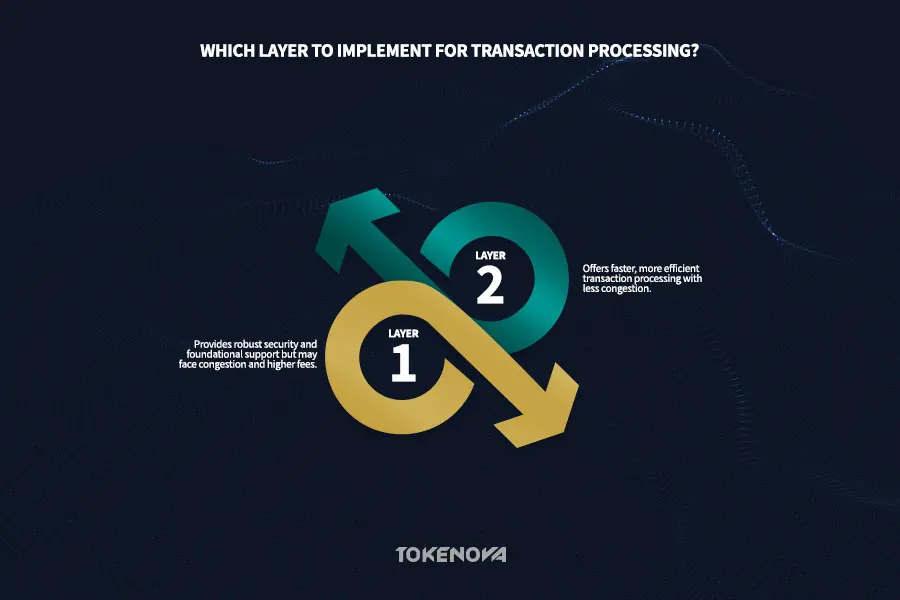
The Evolution of Layer 2 Technologies
The idea of Layer 2 solutions is not new, but its development has been rapid and transformative, especially in recent years. Initial versions focused on basic off-chain transactions, but as the blockchain space matured, so did Layer 2 technologies. We’ve seen a progression from simple state channels to more advanced solutions like sidechains, Plasma, and the currently dominant Rollups.
In 2024, Layer 2 solutions experienced significant growth. Ethereum Layer 2 transactions surged by 48.3% in Q4 2024, highlighting the increasing adoption of scaling solutions like rollups and zk-rollups. These advancements are not just theoretical; they are being actively implemented and adopted by major projects and platforms, driving tangible improvements in blockchain performance and user experience. This continuous evolution highlights the dynamic nature of Layer 2 solutions and their vital role in shaping the future of blockchain technology.

Exploring Common Layer 2 Protocols
The realm of Layer 2 solutions is diverse, with various protocols each providing unique methods for scaling blockchain. Let’s explore some of the most prominent and impactful Layer 2 protocols.
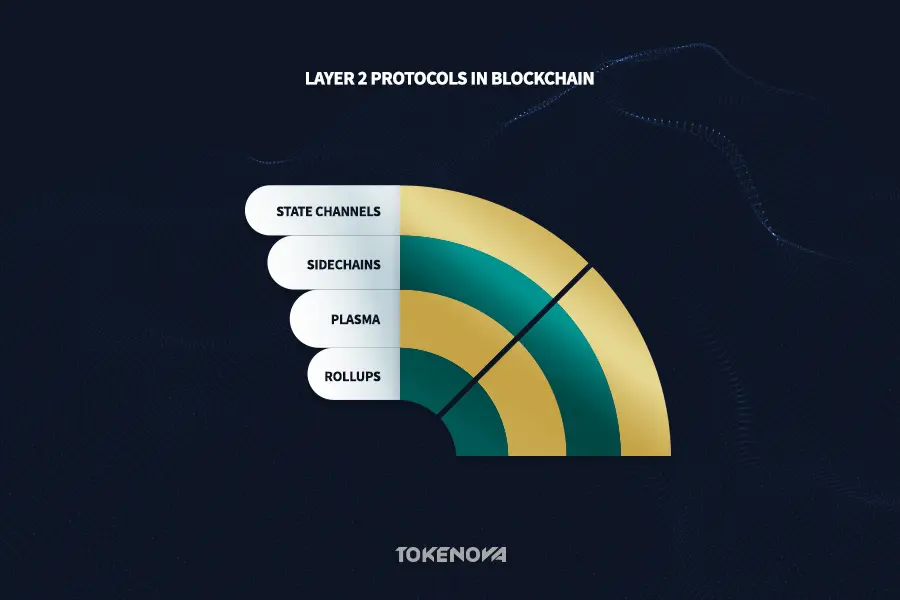
State Channels: Direct and Efficient Transactions
State Channels represent one of the earliest and simplest forms of Layer 2 scaling. They allow two or more participants to conduct multiple transactions off-chain while only submitting two transactions to the main Layer 1 blockchain: one to open the channel and one to close it. All transactions within the channel are conducted privately and instantly between the participants.
State channels are particularly well-suited for applications requiring frequent and fast interactions between a limited number of parties.
- Payment Channels: Enabling rapid and low-cost microtransactions, ideal for micropayments, streaming services, and point-of-sale systems. The Lightning Network on Bitcoin is a prime example of a state channel implementation.
- Gaming: Facilitating real-time interactions and in-game transactions in blockcha blockchain-based games in-based games.
- Peer-to-peer applications: Supporting efficient data exchange and value transfer between users.
Sidechains: Independent Blockchains, Interconnected Power
Sidechains are independent blockchains that run parallel to the main Layer 1 blockchain. They have their own consensus mechanisms and block validation processes but are linked to the main chain through a two-way peg. This peg allows assets to be transferred securely between the main chain and the sidechain.
Sidechains offer greater flexibility and customization compared to state channels. Recent advancements focus on enhancing interoperability and security.
- Cross-chain bridges: Improved bridge technologies are making it easier and safer to move assets between sidechains and the main chain, fostering greater liquidity and utility.
- Interoperable sidechains: Efforts are underway to create sidechains that can communicate and interact with each other, creating a more interconnected and scalable blockchain ecosystem.
- Security enhancements: Research and development are continuously improving the security of sidechains and their bridges to prevent vulnerabilities and exploits. For example, advancements in multi-signature schemes and secure multi-party computation are being explored.
Plasma: Hierarchical Scalability, Complex Architectures
Plasma is a layer-2 solution in blockchain that uses a hierarchical system of child chains connected to the main chain, enabling independent transaction processing and improved scalability. Though initially promising, its complexity has limited adoption compared to Rollups. Still, Plasma’s ideas have influenced other layer-2 solutions, and ongoing research explores its potential in niche use cases like Plasma Cash and Plasma Debit.
Rollups: The Scalability Champions Emerge
Rollups have emerged as the leading Layer 2 scaling solution for Ethereum and other blockchains. They operate by “rolling up” multiple transactions into a single transaction on the Layer 1 blockchain. This significantly reduces the data and computation required on Layer 1, leading to dramatic improvements in scalability and reduced transaction fees. There are two main types of Rollups:
Optimistic Rollups: Trust-Based Efficiency
Optimistic Rollups operate on the principle of “optimistic execution.” They assume that transactions are valid by default and only require fraud proofs to challenge invalid transactions. This optimistic approach allows for faster and cheaper transactions.
Optimistic Rollups have seen significant adoption and demonstrated impressive performance gains. Notable examples include Arbitrum and Optimism, which have become popular Layer 2 networks for DeFi and other applications.
- Increased TPS: Optimistic Rollups can achieve transaction throughput in the range of thousands of TPS, significantly exceeding Layer 1 capabilities.
- Reduced Fees: Transaction fees on Optimistic Rollups are significantly lower than on Layer 1, often by a factor of 10x to 100x.
- Growing Ecosystem: The ecosystem around Optimistic Rollups is rapidly expanding, with a wide range of dApps and projects deploying on these networks. Recent updates include advancements in fault-proof mechanisms and improved developer tooling.
ZK-Rollups: Zero-Knowledge Security and Speed
ZK-Rollups (Zero-Knowledge Rollups) utilize zero-knowledge proofs to ensure transaction validity. They generate cryptographic proofs that demonstrate the correctness of off-chain computations without revealing the underlying transaction data. This provides a high level of security and privacy.
ZK-Rollups are considered by many to be the “holy grail” of Layer 2 scaling due to their combination of scalability, security, and privacy. Technological advancements are driving increased usage.
- Improved ZK-SNARK and ZK-STARK technology: Advancements in zero-knowledge proof systems are making ZK-Rollups more efficient and practical.
- EVM Compatibility: Efforts are underway to improve Ethereum Virtual Machine (EVM) compatibility for ZK-Rollups, making it easier for developers to migrate existing dApps.
- Growing Adoption: Projects like zkSync and StarkNet are gaining traction, demonstrating the potential of ZK-Rollups for scaling various blockchain applications. Recent updates include advancements in recursive proof aggregation and hardware acceleration for ZK-proof generation.
| Protocol | Mechanism | Transaction Speed | Security | Main Use Cases | Examples |
| State Channels | Off-chain, P2P payments | Very Fast (Instant) | Secure (participants only) | Micropayments, Gaming | Lightning Network, Raiden |
| Sidechains | Independent blockchains | Fast (~1000+ TPS) | Moderate (own security) | Cross-chain dApps, NFTs | Polygon PoS, xDai |
| Plasma | Child chains w/ Layer 1 | Fast (~1000+ TPS) | High (Layer 1 anchors) | Scalability for dApps | OMG Network (Old Plasma) |
| Optimistic Rollups | Fraud-proofs on L1 | Fast (2000+ TPS) | Moderate (challenge period) | DeFi, Smart Contracts | Arbitrum, Optimism |
| ZK-Rollups | Zero-Knowledge Proofs | Very Fast (5000+ TPS) | Very High (mathematical security) | DeFi, Payments, Privacy | zkSync, StarkNet |
This table highlights how different Layer 2 protocols enhance scalability, reduce costs, and maintain security, making blockchain faster and more efficient.
Unlocking Blockchain’s Potential: The Benefits of Layer 2
The impact of Layer 2 solutions goes beyond just increasing transaction speed. They unlock a range of benefits crucial for the widespread adoption and real-world applicability of blockchain technology. Let’s explore the compelling advantages.
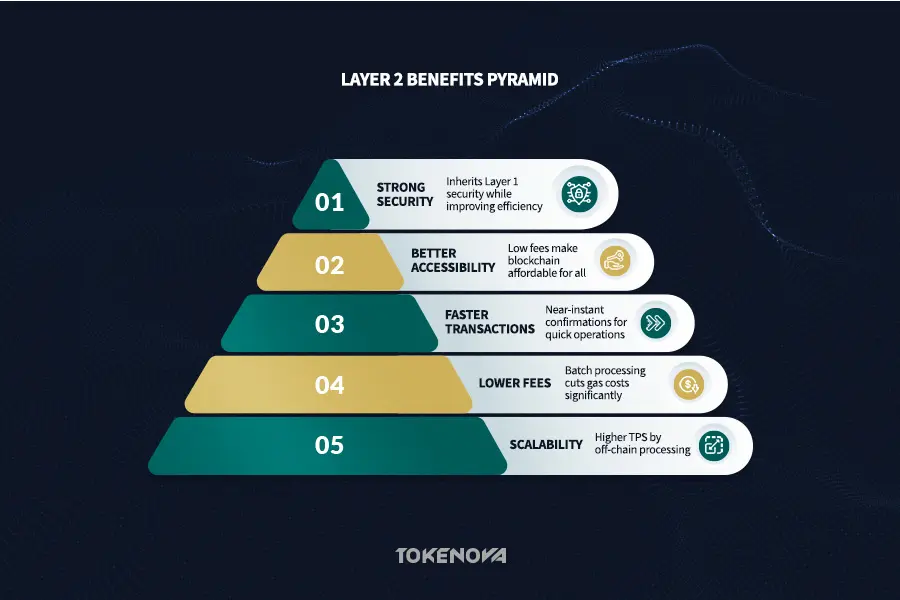
Enhanced Scalability: Meeting Mass Adoption Demands
The most significant advantage of Layer 2 solutions is undoubtedly enhanced scalability. By offloading transaction processing from Layer 1, these solutions dramatically increase the number of transactions a blockchain network can handle. Consider the surge in online transactions during peak shopping seasons; Layer 2 provides the infrastructure to handle similar surges in blockchain activity.
Layer 2 networks like Arbitrum and Optimism are already processing hundreds of thousands of transactions daily, showcasing their real-world scalability. ZK-Rollups are projected to achieve even higher throughput as technology matures. For instance, some ZK-Rollup testnets have demonstrated the potential to reach tens of thousands of TPS. This is a massive leap from the typical 15-30 TPS of Layer 1 Ethereum. L2BEAT provides live data and comparisons of Layer 2 scaling solutions.
Reduced Transaction Fees: Making Blockchain Affordable for All
High transaction fees on Layer 1 blockchains have been a major barrier for many users and applications. Layer 2 solutions drastically reduce these fees, making blockchain more accessible and affordable. Imagine sending a small payment and the transaction fee being higher than the payment itself Layer 2 eliminates this problem.
Transaction fees on Layer 2 networks are typically a fraction of those on Layer 1. In some cases, fees can be reduced by 99% or more. Recent data indicates that the average transaction fee on Optimistic Rollups and ZK-Rollups is often just a few cents, compared to several dollars or even tens of dollars on Layer 1 Ethereum during peak periods. This cost reduction is a game-changer for microtransactions, DeFi applications, and everyday blockchain use cases. EtherScan offers real-time comparisons of transaction fees across different layers.
Faster Transaction Speeds: Enabling Real-Time Experiences
Layer-2 solutions in blockchain greatly enhance transaction speed, solving the slow confirmation issues of Layer 1. Instead of waiting minutes or hours, transactions on Layer 2 are confirmed within seconds—crucial for real-time use. Technologies like Optimistic and ZK-Rollups make near-instant finality possible, boosting blockchain usability. This speed improvement is critical for applications like:
- Decentralized Exchanges (DEXs): Enabling faster trading and order execution, crucial for time-sensitive trading strategies.
- Gaming: Providing seamless and responsive gameplay experiences, essential for immersive blockchain games.
- Retail Payments: Facilitating quick and efficient point-of-sale transactions, making crypto payments practical for everyday use.
Navigating the Layer 2 Landscape: Challenges and Limitations
While Layer 2 solutions offer immense potential, it’s crucial to acknowledge the challenges and limitations that still exist. Addressing these is essential for the continued growth and maturation of Layer 2 technologies. Let’s examine the hurdles and how the industry is working to overcome them.
Security Concerns: Maintaining Vigilance in a Complex Ecosystem
Security remains critical for layer-2 solutions in blockchain. While they benefit from Layer 1’s security, added complexity brings new risks—like smart contract bugs and cross-chain bridge vulnerabilities—similar to adding floors to a solid building that still require precise engineering.
To address these risks, key strategies include:
- Rigorous audits by top security firms
- Formal verification to mathematically ensure code safety
- Decentralized governance for transparent security oversight
- Advanced monitoring for real-time threat detection
Though major breaches are rare, proactive security is essential for maintaining trust in Layer 2 systems.
Complexity of Implementation: Bridging the Developer Skill Gap
Implementing layer-2 solutions in blockchain can be more complex than building on Layer 1, creating challenges for developers and slowing adoption due to a steeper learning curve. To address this, the Layer 2 ecosystem is introducing tools to simplify development:
- Developer-friendly SDKs and libraries help abstract protocol complexities.
- Improved documentation and tutorials offer clearer guidance for integration.
- Abstraction layers enable compatibility with both Layer 1 and Layer 2, easing migration.
- Low-code/no-code platforms expand access to Layer 2 development for non-experts.
Interoperability Issues: Connecting the Layer 2 Islands
While layer-2 solutions in blockchain improve scalability, interoperability between Layer 2 networks and with Layer 1 remains a challenge due to fragmented liquidity and limited cross-chain communication.
Progress is being made to enhance connectivity across the ecosystem:
- Standardized bridging protocols help enable smoother asset and data transfer between networks.
- Cross-Layer 2 communication protocols allow direct interaction between Layer 2s for complex applications.
- Unified liquidity pools reduce fragmentation and boost capital efficiency across networks.
- Atomic swaps and cross-chain DEXs support seamless asset exchange across different Layer 2 environments.
Prominent Layer 2 Solutions in 2025: Scaling Blockchain to the Next Level
As blockchain adoption surges, Layer 2 solutions are playing a critical role in enhancing scalability, transaction efficiency, and affordability across decentralized networks. In 2025, several Layer 2 protocols are leading the charge, offering unique innovations tailored to specific blockchain needs.
Below is an overview of the most prominent Layer 2 solutions in 2025, categorized by their underlying technology and real-world applications.
1. Optimistic Rollups: Speed, Cost Efficiency & EVM Compatibility
Optimistic Rollups, a type of layer-2 solutions in blockchain, assume transactions are valid by default and use fraud proofs only if challenged—resulting in faster speeds and lower fees while preserving Ethereum’s security.
Arbitrum, by Offchain Labs, leads the Optimistic Rollup space with over \$10B TVL. It supports major platforms like Uniswap and Aave, and its Arbitrum Stylus feature allows smart contract development in languages like Rust and C++.
Optimism, backed by the Optimism Foundation, powers 200+ DeFi and NFT projects. Its key 2025 innovation, the OP Stack, enables other Layer 2 networks like Base and Worldcoin’s infrastructure, while keeping fees low.
Base, launched by Coinbase, is the fastest-growing Layer 2, quickly attracting startups and enterprises. Its integration with Coinbase bridges the gap for mainstream blockchain adoption.
Read More: How to Create a Smart Contract on Ethereum
2. ZK-Rollups: High Security, Privacy & Advanced Scalability
zkSync Era, developed by Matter Labs, leads the ZK-Rollup category of layer-2 solutions in blockchain as the first fully live zkEVM, enabling efficient smart contracts with Ethereum-level security. With recursive proof advancements, zkSync now supports higher transaction speeds and is widely adopted in DeFi, gaming, and NFTs.
StarkNet, by StarkWare, uses STARK proofs for quantum-resistant, scalable, and cost-effective transactions. Unlike SNARK-based solutions, it offers enhanced security and has seen strong enterprise adoption, especially for privacy-focused use cases. In 2025, StarkNet is moving toward decentralization.
Polygon zkEVM evolved from a sidechain into a full ZK-Rollup, offering EVM compatibility and affordable scalability. Its integration with major brands like Meta, Nike, and Disney has boosted its presence in the NFT and gaming markets.
3. Other Emerging Layer 2 Solutions
Beyond the main players, emerging layer-2 solutions in blockchain are establishing their own niches. Immutable X revolutionizes NFT and gaming with gas-free minting and fast in-game transactions, adopted by companies like GameStop and Gods Unchained.
Metis, a hybrid rollup, gains attention for its decentralized governance and focus on DAOs, offering scalable, secure, and low-cost transactions, appealing to Web3 startups.
Scroll, a zkEVM rollup launching fully in 2025, aims to ease dApp migration from Ethereum while providing ZK-Rollup security and efficiency. Its developer-friendly design and scalability position it as a promising contender in the Layer 2 space.
Read More: Blockchain Scalability Challenges: Top Solutions for 2025
Real-World Impact: Use Cases of Layer 2 in Blockchain
Layer 2 solutions are not just theoretical concepts; they are already powering a wide range of real-world applications and use cases, demonstrating their transformative potential across various industries. Let’s explore some compelling examples of how Layer 2 is making a difference.
Decentralized Finance (DeFi): Fueling the Financial Revolution
Decentralized Finance (DeFi) is a key use case for layer-2 solutions in blockchain, addressing the need for high transaction throughput and low fees. While Layer 1 faced limitations similar to a slow, costly traditional financial system, Layer 2 is overcoming these challenges.
Leading DeFi projects are adopting Layer 2 to boost performance and user experience:
- Uniswap V3 on Optimism and Arbitrum reduces trading fees and enhances accessibility.
- Aave expands on these networks, lowering borrowing and lending costs to attract users.
- Yearn Finance optimizes yield farming and cuts gas fees via Layer 2.
- New DeFi protocols are being built natively for Layer 2, leveraging its unique features and driving ecosystem growth.
Non-Fungible Tokens (NFTs): Unlocking Digital Asset Potential
Decentralized Finance (DeFi) and Non-Fungible Tokens (NFTs) are two of the most impactful use cases for layer-2 solutions in blockchain. DeFi applications like DEXs, lending platforms, and Yield aggregators require high throughput and low fees, challenges that Layer 1 often struggled with but Layer 2 is resolving.
Leading DeFi projects are deploying on Layer 2 to enhance performance and user experience:
- Uniswap V3 on Optimism and Arbitrum reduces fees and improves accessibility.
NFT platforms also benefit greatly from Layer 2 by lowering minting and trading costs, speeding up transactions, and increasing accessibility for creators and collectors:
- Lower fees empower smaller artists.
- Faster speeds improve trading experiences.
- Layer 2 native NFT marketplaces are emerging to optimize performance and user experience.
Overall, Layer 2 solutions are democratizing access and expanding participation in both DeFi and NFT ecosystems.
Gaming and Virtual Worlds: Creating Immersive Blockchain Experiences
Decentralized Finance (DeFi), NFTs, and gaming are key use cases for layer-2 solutions in blockchain, addressing the need for high throughput, low fees, and scalability that Layer 1 often struggles with.
In DeFi, projects like Uniswap V3 on Optimism and Arbitrum reduce fees and improve user experience, making trading more accessible.
NFT platforms benefit from Layer 2 by lowering minting and trading costs, enabling smaller creators, and increasing accessibility. NFT activity is moving to Layer 2 due to these advantages.
In gaming and virtual worlds, Layer 2 solutions enable faster and cheaper in-game transactions, support scalable virtual environments, and enhance user experience. This is vital for immersive gameplay and play-to-earn models, making these games more sustainable and attractive for developers and players alike.
Choosing Your Path: Comparing Layer 2 Solutions
With a variety of Layer 2 solutions available, choosing the right one for a specific application or use case can be challenging. Understanding the key differences and trade-offs between different Layer 2 protocols is crucial for making informed decisions. Let’s break down the key factors to consider when comparing Layer 2 options.
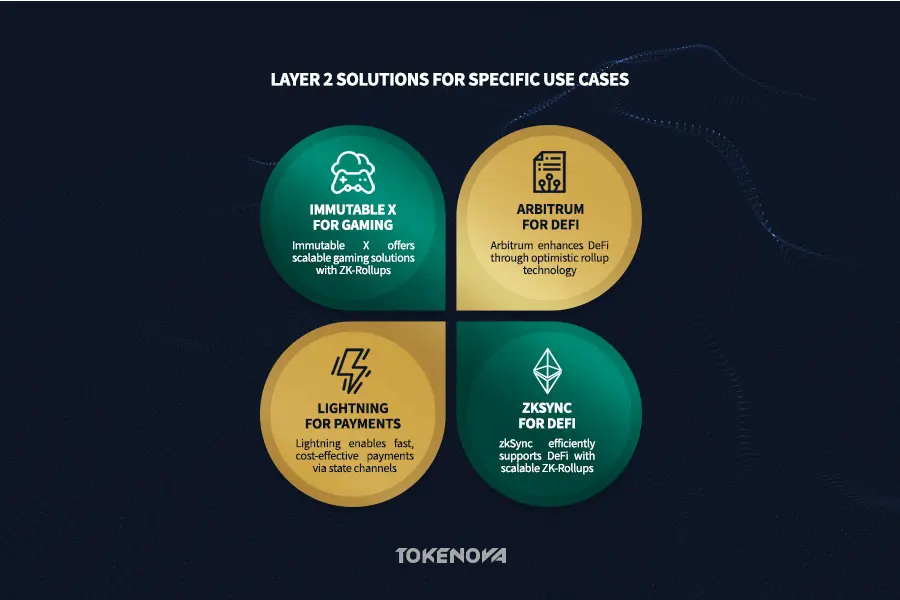
Performance Metrics: Data-Driven Layer 2 Comparisons
Decentralized Finance (DeFi), NFTs, and gaming are key use cases for layer-2 solutions in blockchain, addressing Layer 1 limitations like low throughput and high fees.
DeFi projects such as Uniswap V3 on Optimism and Arbitrum reduce fees and improve user experience, making trading more accessible. NFTs benefit from Layer 2 by lowering minting and trading costs, enabling smaller creators, and speeding transactions, thus democratizing access.
Blockchain gaming and virtual worlds rely on Layer 2 for faster, cheaper in-game transactions and scalable, immersive experiences.
When comparing Layer 2 solutions, key performance metrics include:
- Transactions Per Second (TPS): ZK-Rollups often offer higher TPS than Optimistic Rollups, both outperforming Layer 1.
- Transaction Fees: Both rollups reduce fees significantly, though ZK-Rollups may have higher proof costs.
- Transaction Finality: ZK-Rollups provide faster finality than Optimistic Rollups, which have fraud-proof delays.
- Security: ZK-Rollups generally offer stronger cryptographic security, while Optimistic Rollups depend on fraud proofs and economic incentives.
These factors are crucial for evaluating the efficiency and suitability of different layer-2 solutions in blockchain.
Use Case Suitability: Matching Layer 2 to Application Needs
The best blockchain for smart contracts and Layer 2 solution for a particular use case depends on the specific requirements of the application. Different applications have different priorities, and the optimal Layer 2 choice should align with those priorities.
DeFi: Both Optimistic Rollups and ZK-Rollups are well-suited for DeFi applications. Optimistic Rollups have seen wider adoption due to their EVM compatibility and faster deployment, while ZK-Rollups offer stronger security and privacy. DeFi benefits from both scalability and security.
NFTs: Both types of Rollups are also suitable for NFT platforms. Lower fees are a primary driver for NFT adoption on Layer 2. NFTs benefit greatly from reduced transaction costs.
Gaming: For gaming, low latency and fast finality are crucial. ZK-Rollups may offer advantages in terms of speed and security for complex gaming applications. Gaming demands real-time performance.
Payments: State channels and payment channels are ideal for micropayments and high-frequency payment applications. Payment solutions require speed and low cost for microtransactions.
Adoption and Ecosystem Support: Community and Infrastructure Strength
The level of adoption and ecosystem support is another critical factor to consider when evaluating Layer 2 solutions. A strong ecosystem indicates maturity, reliability, and future growth potential.
Current Adoption Rates: Optimistic Rollups currently have higher adoption rates and a larger ecosystem compared to ZK-Rollups, which are still in earlier stages of development and deployment. Higher adoption often means more mature infrastructure and tools.
Community Backing: Strong community support and active developer communities are essential for the long-term success of Layer 2 solutions. A vibrant community drives innovation and support.
Infrastructure and Tooling: The availability of robust infrastructure, developer tools, and support resources can significantly impact the ease of adoption and development on a Layer 2 network. Good tooling simplifies development and integration.
Read More: Best Blockchain for Tokenization: Your Ultimate Guide
Tokenova: Your Trusted Advisor for Layer 2 & Blockchain Scaling
Scaling your blockchain project? Tokenova provides expert advisory services to help you navigate Layer 2 solutions, optimize costs, and enhance security.
What We Offer:
✅ Layer 2 Strategy & Implementation: Optimistic Rollups, ZK-Rollups, Sidechains & more.
✅ Scalability & Cost Optimization: Reduce gas fees and increase transaction throughput.
✅ Security & Compliance: Smart contract audits & bridge security assessments.
✅ Ecosystem Growth & Partnerships: Connect with top Layer 2 networks & DeFi platforms.
Conclusion
The evolution of blockchain technology hinges on its ability to scale efficiently while maintaining decentralization and security. As adoption grows, the demand for faster transactions, lower fees, and improved network efficiency becomes more pressing. Layer 2 solutions in blockchain have emerged as the definitive answer to these challenges, transforming the way blockchain networks process transactions and interact with decentralized applications.
⚙️Blockchain Fact: As blockchain technology moves toward mass adoption, Layer 2 solutions in blockchain are no longer just an option they are a necessity for enabling faster, more affordable, and scalable decentralized applications.
By leveraging technologies like Optimistic Rollups, ZK-Rollups, Sidechains, Plasma, and State Channels, Layer 2 solutions in blockchain are enabling a more seamless and scalable digital economy. These innovations are already making a tangible impact across various sectors, from DeFi and NFTs to gaming and enterprise blockchain applications. As they continue to evolve, we can expect further improvements in interoperability, security, and user experience, making blockchain technology more accessible than ever.
For developers, businesses, and investors, embracing Layer 2 solutions in blockchain is no longer a choice it is a necessity. Whether it’s reducing transaction costs, improving scalability, or enhancing network efficiency, Layer 2 technology is the key to unlocking blockchain’s full potential. As research and development push these solutions further, we stand on the brink of a new era in blockchain scalability, one where decentralized networks can compete with traditional financial systems in speed, efficiency, and usability.
The future of blockchain is not just about creating secure and decentralized networks it’s about making them practical and scalable for real-world use. With Layer 2 solutions in blockchain, we are closer than ever to realizing a truly global, frictionless, and decentralized digital economy. Now is the time to explore, adopt, and innovate with Layer 2 technology because the next generation of blockchain is already here.
Whether you’re looking to invest in tokenized assets or explore Web3 business opportunities, understanding Layer 2 solutions is essential for navigating the evolving blockchain landscape. For businesses seeking to register a blockchain-based business or explore tokenization applications, Layer 2 solutions provide the infrastructure needed for scalable and cost-effective operations.
Key Takeaways
- Layer 2 solutions enhance blockchain scalability by processing transactions off-chain.
- Key Layer 2 protocols include State Channels, Sidechains, Plasma, and Rollups (Optimistic & ZK).
- Benefits: Enhanced scalability, reduced fees, faster speeds.
- Challenges: Security, complexity, interoperability.
- Use cases: DeFi, NFTs, Gaming, and more.
- Rollups (Optimistic & ZK) are leading Layer 2 technologies.
- Layer 2 is crucial for mass blockchain adoption and Web3 growth.
References:
A Survey of Layer-Two Blockchain Protocols
A Survey on Layer 2 Solutions to Achieve Scalability in Blockchain
Layer 2 Blockchain Scaling: a Survey
Are Layer 2 solutions only relevant to Ethereum, or can they be used with other blockchains?
While Layer 2 solutions are most prominently discussed and developed within the Ethereum ecosystem due to its significant scalability challenges and large developer community, the concept of Layer 2 scaling is not exclusive to Ethereum. Layer 2 solutions can be and are being developed for other Layer 1 blockchains as well. The fundamental principles of off-chain computation and transaction aggregation can be applied to any blockchain that faces scalability limitations. For example, the Lightning Network is a Layer 2 solution for Bitcoin. As other blockchains grow in popularity and face scalability pressures, we can expect to see a wider adoption and development of Layer 2 solutions across the entire blockchain landscape.
What are the potential risks of using bridges to transfer assets between Layer 1 and Layer 2 networks?
Bridges, while essential for interoperability between Layer 1 and Layer 2 networks, and also between different Layer 2 networks, do introduce potential risks. One of the primary risks is smart contract vulnerabilities. Bridges rely on complex smart contracts to lock and mint assets, and vulnerabilities in these contracts can be exploited, leading to loss of funds. Another risk is centralization. Some bridges may be more centralized than others, which can make them a target for attacks or censorship. Furthermore, bridge failures or downtime can disrupt asset transfers and impact users. It is crucial to use reputable bridges that have undergone security audits, have transparent operations, and ideally, are more decentralized. Users should also be aware of the specific risks associated with each bridge they use and exercise caution when transferring significant amounts of assets.
How do Layer 2 solutions impact the decentralization of blockchain technology?
Layer 2 solutions are designed to enhance scalability without compromising the core decentralization of Layer 1 blockchains. In theory, they should maintain or even improve decentralization in certain aspects. By offloading transaction processing to Layer 2, the burden on Layer 1 nodes is reduced, potentially allowing for more participants to run Layer 1 nodes, thus strengthening decentralization at the base layer. However, the decentralization of Layer 2 solutions themselves can vary. Some Layer 2 protocols might have more centralized sequencers or operators, which could introduce centralization risks at the Layer 2 level. The ideal Layer 2 solutions strive for decentralization in their own operations as well, ensuring that the overall blockchain ecosystem remains trustless and censorship-resistant. It’s important to evaluate the decentralization characteristics of specific Layer 2 solutions to understand their impact on the broader blockchain ecosystem.


